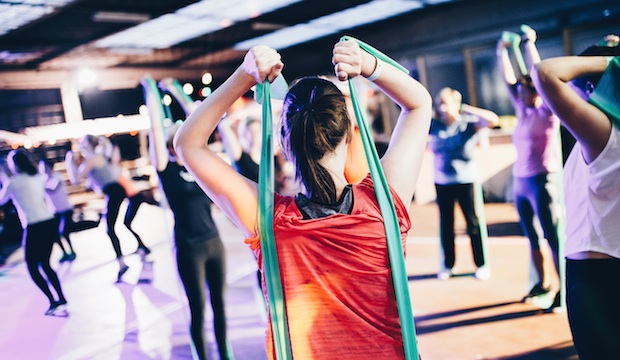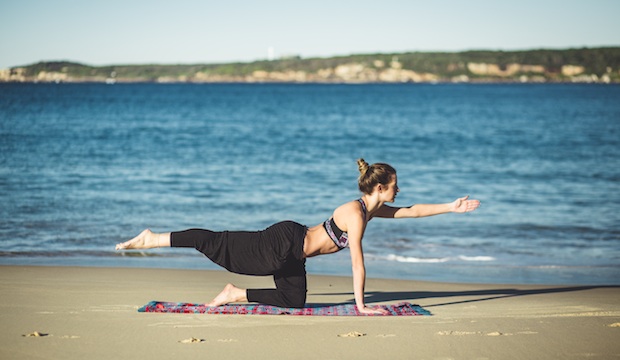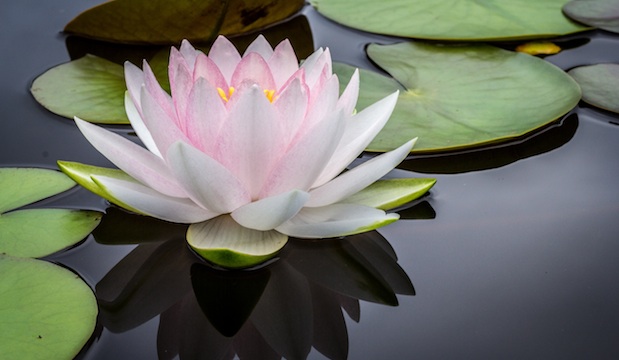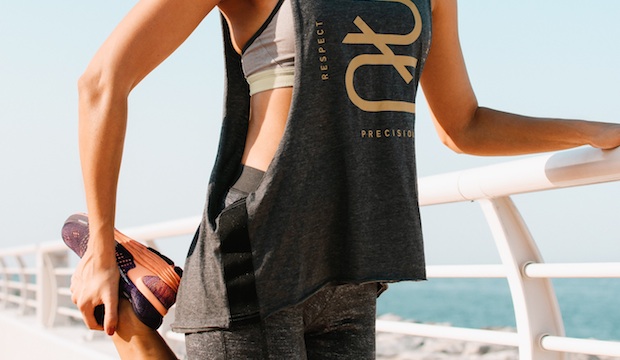Six go-to stretches for your home workout routine
Six go-to stretches for your home workout routine
Most of us enjoy the feeling of working up a sweat. But all too many of us skip the stretching bit, arguably the most important part of the workout.
Stretching can help to promote emotional equilibrium. Tightness or stiffness in the back, hips and legs often leads to tension in the neck and head. This may result in low mood, feelings of anxiety and general stress. Regular stretching can unlock tension in the body and doing so help to increase energy, calm the mind and release pent-up emotions.
It’s also worth noting that endorphins are not just generated through cardiovascular activity. Stretching, in combination with effective breathing techniques, can stimulate these feel-good brain chemicals and give a huge feeling of empowerment. Yoga has long been recognised as a great way to loosen up the limbs and tap into emotional and spiritual energy.

Balancing exercise with a good stretching programme is key to musculo-skeletal health, too. Muscles, tendons and ligaments shorten and tighten during repeated exercise and, if not adequately stretched, can become susceptible to sprains and strains. Stretching the relevant muscles will increase the range of motion in a joint. This can help to reduce stiffness and allow better flexibility and mobility.
Below are our six go-to stretches for improving physical and emotional wellbeing. Do the following programme daily and if time permits twice daily.
Six stretches to try at home

Back stretch
Back pain is often caused by long hours hunched over a laptop. This stretch will help to create flexibility in the spine and open the spaces between the vertebrae.
Pectoral (chest) stretch
This will help to open out the chest and stretch the intercostal muscles between the ribs, to facilitate deep, even breathing. It can help with poor upper body posture and relieve upper back pain caused by hunching.

Standing hamstring stretch
This stretch will lengthen the hamstrings (backs of thighs). Tight hamstrings are a common contributor to lower back pain as they can cause the pelvis to tilt back and the lower back muscles to tighten. They are connected to the ischial tuberosities (part of the pelvic bones).
Quads and hip flexor stretch
This stretch will help to ease tension in the front of the thigh. Tight quads, the main front thigh muscle group, can cause knee pain. Tight hip flexors, (the muscles at the top of the thigh) can cause lower back pain – the hip flexor known as the psoas muscle connects with the lower back vertebrae.

Glutes stretch
Tightness in the glutes can cause impingement of the sciatic nerve and consequent pain in the back and down the leg. This stretch can help to ease tension in the muscle that causes the impingement and thereby relieve the pain.
Neck stretches
Bad posture and forward-jutting head can cause significant neck and head pain. Stretching the neck sideways, forwards and backwards can help to ease neck and shoulder pain.
Stretching can help to promote emotional equilibrium. Tightness or stiffness in the back, hips and legs often leads to tension in the neck and head. This may result in low mood, feelings of anxiety and general stress. Regular stretching can unlock tension in the body and doing so help to increase energy, calm the mind and release pent-up emotions.
It’s also worth noting that endorphins are not just generated through cardiovascular activity. Stretching, in combination with effective breathing techniques, can stimulate these feel-good brain chemicals and give a huge feeling of empowerment. Yoga has long been recognised as a great way to loosen up the limbs and tap into emotional and spiritual energy.

Balancing exercise with a good stretching programme is key to musculo-skeletal health, too. Muscles, tendons and ligaments shorten and tighten during repeated exercise and, if not adequately stretched, can become susceptible to sprains and strains. Stretching the relevant muscles will increase the range of motion in a joint. This can help to reduce stiffness and allow better flexibility and mobility.
Below are our six go-to stretches for improving physical and emotional wellbeing. Do the following programme daily and if time permits twice daily.
Six stretches to try at home

Back stretch
Back pain is often caused by long hours hunched over a laptop. This stretch will help to create flexibility in the spine and open the spaces between the vertebrae.
- Come to all fours on the mat with wrists under shoulders, knees hip-width apart and back flat.
- Inhale as you tilt your head backwards, raise your tailbone to the sky and arch your back and belly down towards the floor (concave arch.)
- Exhale as you arch your back upwards, tucking your tailbone under and drawing your chin towards your chest.
- Continue this arching and hollowing of your back to the rhythm of your breath for at least 30 seconds.
- Rest and repeat.
Pectoral (chest) stretch
This will help to open out the chest and stretch the intercostal muscles between the ribs, to facilitate deep, even breathing. It can help with poor upper body posture and relieve upper back pain caused by hunching.
- Stand just in front of a door frame with your arms at right angles to your sides and forearms resting perpendicularly on the sides of the door frame.
- Move your feet back a few inches, keeping them together.
- Keeping your lower arms and hands against the doorframe, gently allow your body to push forwards, keeping your back straight and engaging your front abdominal muscles.
- As you push forwards with your body roll on to your tiptoes and feel the stretch in the upper chest.
- Hold this stretch for at least 30 seconds.
- Rest and repeat.

Standing hamstring stretch
This stretch will lengthen the hamstrings (backs of thighs). Tight hamstrings are a common contributor to lower back pain as they can cause the pelvis to tilt back and the lower back muscles to tighten. They are connected to the ischial tuberosities (part of the pelvic bones).
- Stand upright with your feet hip-width apart and, as you inhale, raise your arms to the ceiling, then hinge from the hips and draw your body down towards the floor.
- Try to keep your legs as straight as you can.
- Gently ease into this stretch, folding forwards from your lower back. Fingertips stretch towards the floor.
- Keep breathing deeply and evenly. On each exhale you should get a little bit more flexibility.
- Hold this stretch for at least 30 seconds.
- Rest and repeat.
Quads and hip flexor stretch
This stretch will help to ease tension in the front of the thigh. Tight quads, the main front thigh muscle group, can cause knee pain. Tight hip flexors, (the muscles at the top of the thigh) can cause lower back pain – the hip flexor known as the psoas muscle connects with the lower back vertebrae.
- Stand upright with shoulders square and ears in line with shoulders. Hips should be facing forwards.
- Bend your right leg at the knee and take the foot in your right hand, drawing your foot back towards your bottom. (You may need to assist your balance by holding on to the back of a chair or other surface with your left hand.)
- Keep your thighs in line with each other.
- Gently push your hips forwards and tuck your bottom under to feel the stretch in the front of the thighs and hip flexors.
- Hold this stretch for at least 30 seconds on each leg.
- Rest and repeat.

Glutes stretch
Tightness in the glutes can cause impingement of the sciatic nerve and consequent pain in the back and down the leg. This stretch can help to ease tension in the muscle that causes the impingement and thereby relieve the pain.
- Sit with your legs crossed and back upright.
- As you inhale draw your body up so that your spine is long.
- As you exhale draw your body downwards towards the floor, hinging from the hip and initiating the movement from the lower back. Continue to ease into this stretch on each exhale.
- Arms should be outstretched in front of you.
- Hold this stretch for at least 30 seconds.
- Rest and repeat.
Neck stretches
Bad posture and forward-jutting head can cause significant neck and head pain. Stretching the neck sideways, forwards and backwards can help to ease neck and shoulder pain.
- Sit or stand with your back upright and shoulders square but relaxed.
- Your head should be facing forward and ears in line with your shoulders.
- Slowly lower your head to the right so that the right ear moves towards the right shoulder. Don’t let the left shoulder rise.
- Hold this position for at least 30 seconds.
- Then repeat on the left side.
- Return to the start position and take the chin downwards towards the chest. Don’t worry if you can’t touch the chest with the chin. Hold the stretch for at least 30 seconds.
- Then raise the head to the starting position.
- Slowly tilt the head backwards so that the occipital bone (the back of the skull) moves towards the upper back.
- Hold for at least 30 seconds and return to the starting position.
- Rest and repeat.
TRY CULTURE WHISPER
Receive free tickets & insider tips to unlock the best of London — direct to your inbox